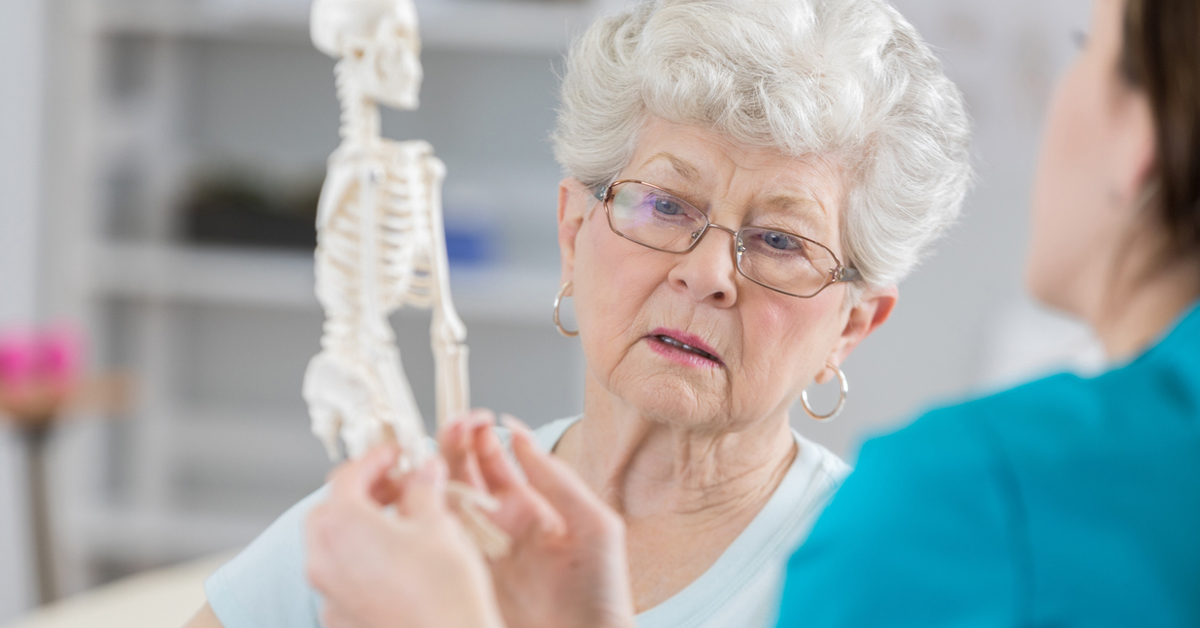There is a skeleton inside you. Some may find the thought a little creepy, but ultimately, thinking about your bones is key to lifelong health, wellness, and activity.
From a young age, we’re taught about calcium and encouraged to drink plenty of milk. Even so, many of us spend our adolescent or teenage years breaking a bone or two before learning any valuable lessons.
Beyond that, we tend to forget the skeleton inside us until something goes wrong. For at least 3 million Americans each year, osteoporosis is that wakeup call about bone health.
What is osteoporosis?
Meaning “porous bone,” osteoporosis is a bone disease causing weakness and brittleness, most notably in the bones of the hip, wrist, or spine.
However we may think about our bones, they are made up of living tissue much like the rest of us. As the loss of old bone outpaces the growth of new bone, or when new bone growth diminishes drastically, we may experience fractures from the smallest events. Bumps and even sneezes have been known to cause breaks.
According to the Mayo Clinic, osteoporosis affects men and women of all races. However, older white and Asian women–especially those beyond menopause–are at greatest risk.
What are the symptoms?
At the outset, bone loss has few noticeable symptoms. Osteoporosis most commonly presents with an unexpected fracture before a diagnosis is made.
Osteoporosis patients may experience frequent back pain from fractured or collapsed vertebra, a loss of overall height, a stooped or difficult posture, and additional fractures from minor events.
What are the causes?
The production of new bone mass slows naturally as we age. Bone growth outpaces bone loss while we’re young but reverses past our early 20s. At 30 years of age, many of us reach peak bone mass. Beyond that age, bone mass is generally lost faster than it can be created.
The amount of bone mass we accrue throughout our youth can change our chances at developing osteoporosis when older. Other contributing factors include gender (women are more likely than men), race (white and Asian), and family history (a close family member).
The size of your body’s frame can also contribute to the amount of bone mass you develop before the aging process slows production. In a manner of speaking, men and women of smaller frames have less bone to lose.
Still other factors include hormone production, diet, medication, medical conditions, and lifestyle choices.
How is it treated?
Treatment for osteoporosis consists of multiple approaches for strengthening bone. Supplements and dietary changes can contribute to bone health while weight-bearing exercises encourage growth. Hormones and vitamins may also be used to treat bone loss.
Osteoporosis prevention uses many of the same methods as treatment. Getting plenty of protein and maintaining an appropriate body weight (as opposed to being underweight) may contribute to your long term bone health. Calcium and vitamin D (both in our food and our supplements) can also help prevent or slow bone loss.
Strength training and balance exercises–weight lifting, walking, jogging, yoga, tai chi–promote bone density in both upper and lower extremities. The better habits you develop (especially in your youth) the less likely you are to develop osteoporosis.
Osteoporosis 101
Though a common disease with hereditary factors, osteoporosis can be treated and prevented with dietary changes, exercise, and supplements.
If you experience an unexpected fracture from a mild action or bump, schedule an appointment with your physician for a proper diagnosis.
UAB Medical West is committed to helping our communities understand the health issues they’re facing.
Osteoporosis affects 3 million Americans every year, most of them middle-aged or elderly. If you or a loved one experienced an unexplained fracture, you should consult a physician for a proper course of healing and a bone mineral density test. Serving Hueytown, Hoover, Bessemer, McCalla, and Vance, UAB Medical West encourages you to remember the skeleton inside!
